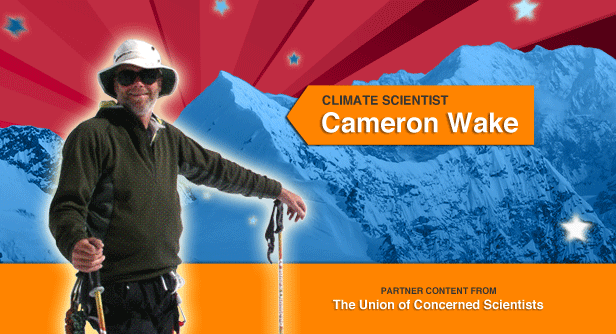It takes a certain kind of person to gather ice cores from remote glaciers, cart them back to a lab, and unlock the clues they contain about the climate record. Such a person needs to be hardy and skilled enough in the field to lead expeditions loaded with equipment into some of the world’s most rugged-and frigid-mountain terrain. Back at the lab, this person needs technical acumen and a meticulous attention to detail in order to measure the cores’ trace chemicals down to the parts-per-trillion level. To be a glacial detective, in other words, a person needs to be a little Stephen Hawking and a little Indiana Jones, which pretty much describes Cameron Wake, a daring climate geek from the University of New Hampshire.

Wake fell in love with mountains at age 14, while he was in a rigorous climbing program in the Canadian Rockies. Straight out of college with a degree in geology, he got a job monitoring a glacier’s movement. “Once I was paid to work on a glacier, it was all over,” he says with a chuckle. “My career path was set.”
At 23, Wake landed a job with a scientific expedition studying glacier hydrology in the Karakoram Mountains of northern Pakistan. Because of his mountaineering and skiing skills, the team trusted him to gather data in the most remote regions of the glacier. “I was hooked,” says Wake, who spent four consecutive summers in Pakistan’s mountains.
After completing his master’s degree in geography, he went on to the University of New Hampshire for a PhD in earth sciences. His specialty? The climatic and environmental evidence locked inside the icy interior of glaciers. Since earning his PhD, Wake has led or collaborated in expeditions that have collected and analyzed glacial ice cores from Antarctica to Kyrgyzstan. He has coauthored dozens of peer-reviewed scientific papers analyzing the data from those cores.
“Glaciers present a superb archive of how humans have dramatically changed the Earth’s atmosphere,” Wake says. “If you put out a call for engineers to design a system that stored pristine samples of the atmosphere for hundreds of thousands of years, I doubt they could design a better system than glaciers.”
Before Wake can study glacial cores, he has to get them, and that requires drilling them out. Even under the best circumstances the job is a logistical nightmare; sometimes, it’s damn near impossible. In the Himalayas, says Wake, the terrain was so treacherous and the elevations so high that his team couldn’t land a helicopter — even if the local authorities had allowed them to use one. Instead, expedition members had to carry virtually all the equipment and the frozen cores.
For the job, Wake’s team developed a whole range of lightweight, flexible gear. The centerpiece of the effort, the so-called Eclipse drill, which can bore hundreds of meters into the ice, could be broken down into parts small and light enough to be carried. This ingenious workhorse, powered by solar panels, removes ice cores one meter at a time. The Eclipse performs with remarkable efficiency, but boring down hundreds of meters is long, painstaking work, and anything can happen. The core barrel, for example, can get stuck, and the drill might need to have its teeth sharpened. “Let’s put it this way,” Wake quips: “you’re happy when the boring is boring.”
Once the core samples arrive back at the University of New Hampshire, they are temporarily housed in a freezer the size of a small house. Wake thinly slices the cores in clean-room conditions, and using elaborate procedures melts out their centers while avoiding any possibility of contamination. Then the high-tech analysis begins.
“Basically,” Wake says, “we’re looking at very specific kinds of impurities in the snowflakes that have fallen and in the atmospheric dust that has settled to create the glacier’s historical record.”
A large number of chemical compounds trapped in the ice can provide a chronicle of both local and global changes in the atmosphere at a given time. Wake and his colleagues can detect the unmistakable buildup of greenhouse gases, such as carbon dioxide, that are causing the planet to warm. The seasonal fluctuations of sea salt and stable isotopes of oxygen and hydrogen trapped in the ice are like tree rings. By reading them, Wake’s team dates the samples precisely. In an ice core from central Greenland, for instance, scientists counted back through 80,000 years of seasonal fluctuations. Levels of the same isotopes in the samples were good indicators of changes in temperature at different periods in the past.
Wake and his colleagues read other chemical traces as though they were scouring a stack of old newspapers. The sudden appearance of radioactive cesium, for instance, marks the advent of aboveground nuclear tests by the United States and the Soviet Union prior to the 1963 test-ban treaty. And even in the planet’s most remote glaciers, Wake detects the surge in lead that heralds the rise of the automobile. The changes are unmistakable, “like a baseball bat hitting you on the head,” he says. The evidence of global warming that is buried in glacial ice, he says, has been clear for decades. But finding it is not enough. Glacier scientists like Wake want to describe not just how the climate has changed but why.
“It is a lot like cancer research,” Wake says. “There is much more work to be done to understand exactly how cancers are triggered and how they develop. But we still know more than enough to deal with and treat individuals with cancer, sometimes with remarkable success. The same is true with climate change research. The planet’s climate is an exceedingly complex system, and there is still a lot to learn about exactly how it operates. Nonetheless, we know more than enough to act, and the treatment for the planet is clear: as quickly as we possibly can, we need to reduce the levels of greenhouse gases we are emitting and make the transition to a more sustainable future that includes greener energy technologies.”
This is the third installment of America’s Climate Scientists: A series from the Union of Concerned Scientists. Click here to read all the climate scientist profiles.
The Union of Concerned Scientists is currently leading a campaign to elevate the voices of climate scientists and educate the public about the overwhelming scientific evidence for human-caused global warming. Learn how you can get involved at www.ucsusa.org/evidence.



